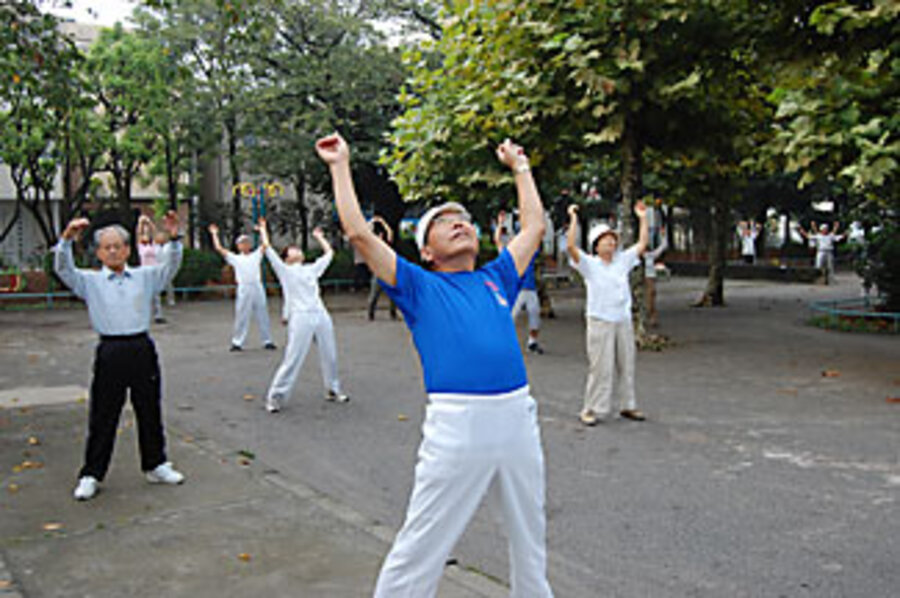In Japan, cutting costs with seaweed and sit-ups
Loading...
| Tokyo
Call it seaweed versus the Big Mac.
The traditional Japanese diet – tofu, rice, fish, and, yes, mineral-rich nori – is famous for being considered healthy. The typical American diet – fill in your own favorite fatty food here – is seen as far less so.
That is one reason Japan always comes out on top in world rankings of life expectancy (83 years versus 78 years in the US). It is also why Japan has among the lowest obesity rates in the world.
These factors have helped contribute to Japan's low healthcare costs. The simple fact is, if you aren't sick as much in the first place, you won't tax the system as much in the second place.
Yet the widespread availability of healthcare in Japan also plays a significant part in the country's physical well-being. Japan's system routinely ranks among the highest in effectiveness and efficiency.
Ironically, Japan's universal approach to healthcare – an idea still highly controversial in the US – owes its beginnings to American influences. In postwar Japan, the emphasis on education and healthcare by the General Headquarters of the Allied Forces (under Gen. Douglas MacArthur) contributed to the country's establishment of universal coverage in 1961.
To this day, the system reflects the Japanese sense of egalitarianism. How much a person makes doesn't influence the quality of care or how often someone sees a doctor. "It's not for profit – insurers don't earn a profit," says Yuki Minagawa, a nurse-turned-journalist who covers medical issues. [Editor's note: The original version misspelled Yuki Minagawa’s last name.]
Everyone in the island nation of 127.5 million is required to have health insurance either at work or through a local insurer. Premiums are based on a person's salary and split between the employer and employee. No appointment is needed to see a doctor. A special national health insurance program aids those over 70.
"That enables them to go see a doctor often," says Takao Suzuki, director of the National Institute for Longevity Sciences in Obu, Japan. The number of Japanese centenarians recently surpassed 40,000 for the first time.
The government health ministry keeps the price of healthcare low. That contributes to maintaining insurance premiums between $130 and $180 a month for the average Japanese family. Japanese pay 20 to 30 percent of the cost of medical care out of their pockets, those over 70 pay 10 percent, and parents pay 20 percent for preschool children.
Japan's healthcare costs make up 8 percent of GDP, about half that of the US. In addition to tight government control, frequent visits to doctors – the Japanese are three times more likely to see a doctor than Americans are – also help keep healthcare costs low, says Kim Phyo, professor of neurosurgery at Dokkyo Medical University in Saitama.
Japan has few malpractice suits as well.
Still, the Japanese system has plenty of shortcomings. Medical care is uneven across the country. Overused emergency rooms turn away patients in some areas. Doctor availability and training vary widely. Many small hospitals don't have the expertise or facilities to handle specialized needs like intensive care.
Though most hospitals in Japan are private, doctors at government-run institutions make modest salaries. "Doctors complain of low pay and hard work," says Yusaku Tazawa, a pediatrician at Sendai Medical Center, a state-run hospital. "So, when they get older, some of them quit to start their own [practice]."
While many elements of the Japanese healthcare system probably wouldn't be politically acceptable in the US, Americans can learn a few things from the Japanese about diet and lifestyle. Even though obesity rates are rising here as the Japanese eat more Western food, the prevailing eating patterns are seen as far healthier.
"The people eat more fish while Westerners eat meat," says Masaaki Takeuchi, a former professor at the Tokyo University of Agriculture.
Exercise, too, is ingrained in the culture. Radio calisthenics – morning exercise music played over the airwaves – is popular. Ironically, this, too, was an American import, inaugurated in 1928 after Japanese officials saw it done at a company in New York. Today 76 percent of Japanese primary schools let their students perform radio calisthenics; 25 million people in all participate in them.





